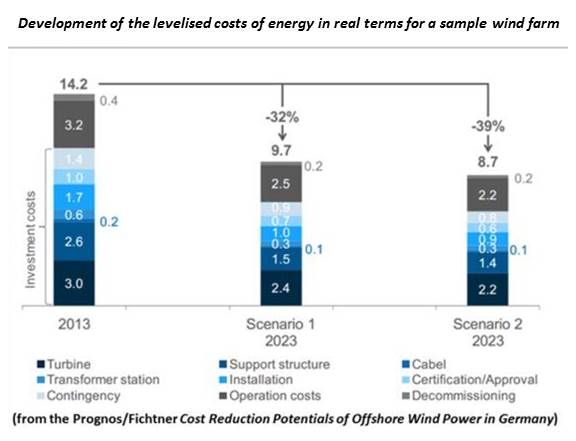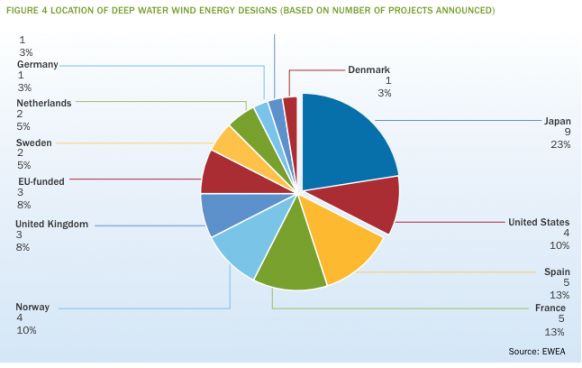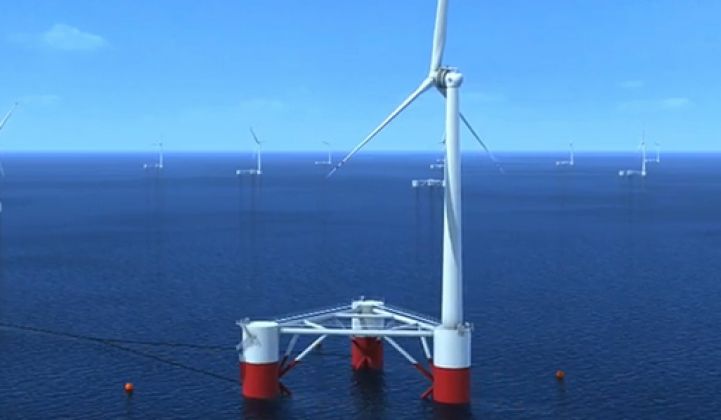Studies indicate that building floating turbines in deeper waters off Europe’s coasts will improve wind energy’s yield and could cut offshore wind costs.
These studies are relevant in light of Deepwater Wind CEO Jeffrey Grybowski’s claiming that offshore wind is “significantly less expensive than solar energy." Grybowski said his planned 1,000-megawatt wind project off Rhode Island would produce electricity at $0.13 to $0.14 per kilowatt-hour and Massachusetts' Cape Wind has contracts to deliver offshore wind-generated electricity at $0.185 per kilowatt-hour. PolitiFact found eighteen solar contracts with National Grid in Rhode Island ranging from $0.185 to $0.33 per kilowatt-hour.
The present levelized cost of energy (LCOE) for Germany’s roughly 400 megawatts of operational North and Baltic Sea wind is 12.8 euro cents ($0.169) to 14.2 euro cents ($0.188) per kilowatt-hour, according to the report Cost Reduction Potentials of Offshore Wind Power in Germany from Prognos AG and Fichtner Group researchers.
The report estimated that those costs can come down between 32 percent and 39 percent as technology reduces investment costs and operations and maintenance costs, in turn bringing about reductions in the cost of capital for financing projects.
The offshore wind ramp-up is already well underway in Europe. According to the report, there are 2,000 megawatts under construction, as well as 4,000 megawatts approved in the North Sea and 1,200 megawatts approved for the Baltic Sea. Germany’s offshore wind installed capacity will be an estimated 6,000 to 10,000 megawatts by 2020.

That barely taps the potential of ocean wind farther offshore, according to the report Deep Water: The Next Step for Offshore Wind Energy from the European Wind Energy Association (EWEA).
The report grew out of meetings in October 2011 through June 2012 with sixteen EU companies now operating floating, deep-water offshore technology or researching it. Europe’s offshore wind installed capacity at the end of 2012 was just under 5 gigawatts, EWEA reported, with another 4,460 megawatts under construction and approximately 18,000 megawatts approved.
Looking to the potential in waters deeper than 40 to 50 meters, farther off the coasts of Europe’s waters, there are presently 141 gigawatts of wind “either on-line, under construction, consented or planned.” Projections based on those numbers suggest the 2020 installed capacity could reach 40 gigawatts, producing 140 terawatt-hours of electricity to meet about 4 percent of Europe’s demand.

Over 80 percent of development in this decade would be in the North Sea and the Baltic Sea, though there is likely to be exploration of potential in the Mediterranean Sea. To fully exploit the 22 gigawatts of potential in the Atlantic, the 16 gigawatts of potential in the Mediterranean, and the not-yet-fully-estimated potential in the deeper parts of the North Sea, “Deep offshore designs are required.”
The report concluded that with “a supportive legislative framework” and “new offshore designs” to get wind beyond 40-meter to 50-meter depths, “the first deep offshore wind farms could be installed and grid connected by 2017” at a competitive LCOE.
Such development would “meet the EU’s electricity consumption four times over,” the report pointed out, and “as deep offshore capacity increases, expertise, skills and technologies developed in Europe can be exported across the globe, initially to Japan and the U.S.”




